There are over 40 different types of spiders in Minnesota. If you’re here because you want to know which spiders in Minnesota to steer clear of, you’re in luck. Minnesota doesn’t have any particularly dangerous spiders.
This shouldn’t be surprising news. Worldwide, there are thousands of spider species. But only about 30 of these spiders inflict medically significant bites. Fortunately, none of these are in Minnesota, not even the infamous black widows.
Like elsewhere, the spiders in Minnesota generate mixed reactions from people. Depending on how much you know about these critters, you might think of them as creepy and intolerable or fascinating and nice to have around.
Spiders are fascinating. And while some sure seem creepy, they are generally good to have around. The spiders in Minnesota, in particular, are harmless and can help you control the populations of other less pleasant arthropods.
If you’re concerned about the messy webs some species spin, don’t be. Not all spiders spin dirty or large, obstructive webs.
Many species, such as jumping and crab spiders, are lively and make do without spinning annoying webs. Keep reading to learn more about the different types of spiders in Minnesota.
Table of Contents
Spiders in Minnesota
1. American Nursery Web Spider
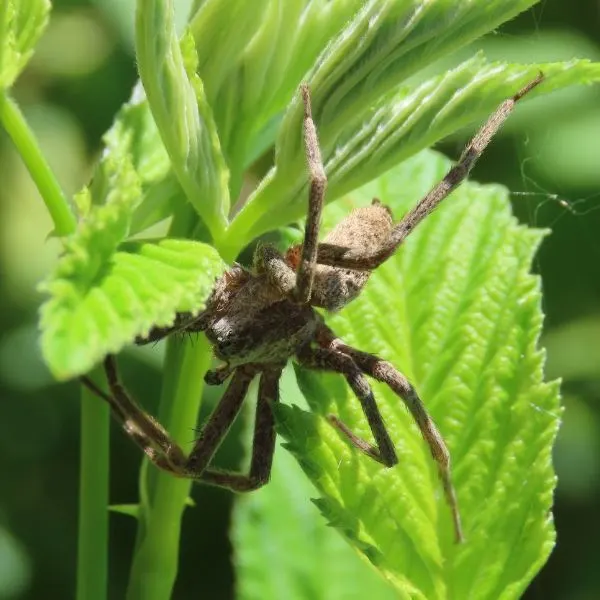
- Experience Level: Beginner
- Family: Pisaurina
- Scientific Name: Pisaurina mira
- Other Names: Nursery Web Spider
- Adult Size: 0.35 to 0.7 inches
- Lifespan: 1 to 2 years
- Average Price Range: N/A
American nursery web spiders live in several US states and in parts of Europe.
They often live in meadows and damp woodlands. However, you’ll also frequently sight them in prairies and places with tall grasses. Indoor sightings are less common.
Most people are familiar with spiders that build webs to trap prey. American nursery web spiders don’t.
Instead of spinning sticky web traps, they prefer sneaking up or openly attacking their prey. They inject their victims with venom before consuming them.
Like other spiders in Minnesota, American nursery web spiders are carnivorous. They feed mainly on insects and other arthropods. Sometimes other spiders are their victims.
Even though American nursery web spiders don’t spin typical webs for prey, they have silk glands. Females usually use their silk glands to spin protective sacs for their eggs. They guard these eggs until hatching.
Although female American nursery web spiders aren’t always cannibalistic towards males, males don’t take any chances. Males typically tie females up before mating, possibly to protect themselves. Females can easily break out the strands later.
You can identify American nursery web spiders by their yellowish to light brown bodies. The back has a dark brown band running down the middle, from the cephalothorax to the abdomen.
These arachnids can walk on water, and they often use this to their advantage when escaping predators. Sometimes they even dive underwater to escape predators that can’t survive in water.
2. Yellow Garden Spider

- Experience Level: Beginner
- Family: Araneidae
- Scientific Name: Argiope aurantia
- Other Names: Black And Yellow Argiope, Black and Yellow Garden Spider, McKinley Spider, Zipper Spider, Golden Garden Spider, Zigzag Spider, Corn Spider, Steeler Spider
- Adult Size: 0.75 to 1.1 inches
- Lifespan: 1 year
- Average Price Range: N/A
The black and yellow garden spider goes by many names, most of them informed by its beautiful coloration.
This species has a large black and yellow abdomen. In most individuals, the middle strip of the abdomen’s upper side is black with pairs of yellow or whitish spots.
The sides of the abdomen are often a mix of black and yellow. However, the dominant color here usually varies with individual spiders. The carapace is covered in whitish hair, while the spiny legs have light and dark bands.
You’ll often come across these spiders in gardens, hanging upside-down in their large webs. Many people are wary of these spiders and remove them from their gardens, even though the spiders are beneficial.
The fear of yellow garden spiders likely stems from their large size and the potentially painful bites they sometimes inflict. But this shouldn’t bother you.
Black and yellow garden spiders don’t bite unless provoked, and even when they do, their bite is not medically significant to humans.
3. Banded Garden Spider
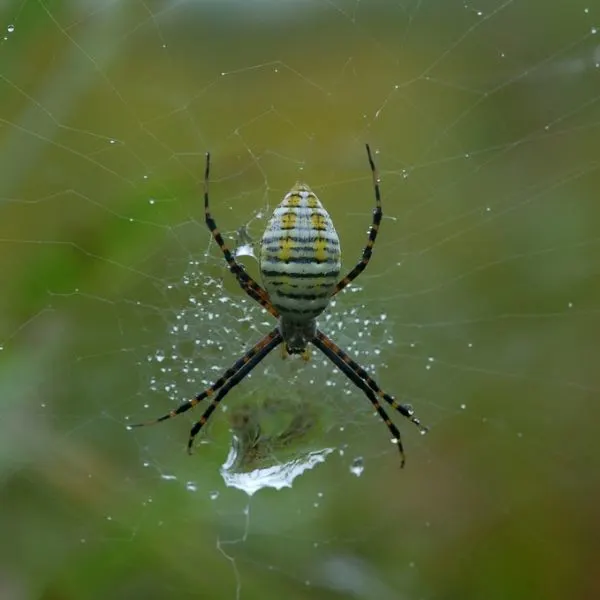
- Experience Level: Beginner
- Family: Araneidae
- Scientific Name: Argiope trifasciata
- Other Names: Orbweaver Spider, Yellow Garden Spider
- Adult Size: 0.59 to 0.98 inches
- Lifespan: 1 year
- Average Price Range: N/A
Banded garden spiders are cousins of black and yellow garden spiders.
But, unlike their relatives, their abdomen isn’t significantly wider than their cephalothorax. Instead, the abdomen of this species is long and banded from side to side with white, yellow, and sometimes orange lines.
Like the yellow garden spider, this arachnid has a carapace covered in whitish hair and long, banded legs bearing spines. It favors gardens and areas with green vegetation, where it spins large concentric webs.
Banded garden spiders often hang with their heads downwards in the center of their webs, waiting for prey. They are pretty agile, so they quickly immobilize any prey tangled in their webs.
These critters feed primarily on insects, but they will eat nearly any arthropod they successfully overpower. They inject their victims with venom before consuming them. Fortunately, their venom is harmless to humans.
There’s no need to panic if you come across this spider in your yard. Banded garden spiders don’t attack people, and bites are rare.
4. Cross Orbweaver

- Experience Level: Beginner
- Family: Araneidae
- Scientific Name: Araneus diadematus
- Other Names: Crowned Orb-weaver, Cross Spider, Diadem Spider, European Garden Spider
- Adult Size: 0.22 to 0.79 inches
- Lifespan: 1 year
- Average Price Range: N/A
The European garden spider is related to the banded garden spider, but it belongs to a different genus. Like its relatives, it has long, spiny legs.
But the abdomen of this species has a cross-like pattern of white or yellowish dots on the upper side. This pattern is why it’s also called a cross-spider.
This arachnid is an orb-weaving spider, so you’ll often see it resting in large, spherical webs. These webs double as traps for prey, so it doesn’t have to leave its shelter to hunt for food.
The European garden spider is merciless towards prey, but it is harmless to humans. Your pets are safe, too—European garden spiders don’t attack animals they can’t overpower, except provoked.
You’ll usually see this species outdoors in forests, grasslands, and gardens around people’s homes. But indoor sightings are uncommon.
5. Red-spotted Ant Mimic Spider

- Experience Level: Beginner
- Family: Corinnidae
- Scientific Name: Castianeira descripta
- Other Names: Ant Mimic Spider
- Adult Size: 0.2 to 0.4 inches
- Lifespan: 1 year
- Average Price Range: N/A
Ant mimic spiders are a fascinating set of spiders, and red-spotted ant mimic spiders are one of the most prominent members of this arachnid collection. Unlike most spiders in Minnesota, ant mimic spiders hunt prey on the ground instead of spinning webs to catch them.
But what’s unique about ant mimic spiders isn’t that they hunt; it’s how they do it. Red-spotted ant mimic spiders often walk around with their first pair of legs raised up like antennae. So if you don’t look closely, you might mistake them for the six-legged ants they imitate.
Their black bodies and the reddish spots on their slightly bulbous abdomens also help in making them look like true ants. As hunters, this camouflage helps them get close enough to ant prey before attacking them.
Red-spotted ant mimic spiders aren’t dangerous to humans, but some people erroneously think they are. That’s because their abdominal red markings are similar to those of black widows.
But if you’re in Minnesota, there’s no need to worry. You won’t find black widows here.
6. Spitting Spider

- Experience Level: Beginner
- Family: Scytodidae
- Scientific Name: Scytodes thoracica
- Other Names: Spitting Spider
- Adult Size: 0.15 to 0.25 inches
- Lifespan: 1.5 to 2 years
- Average Price Range: N/A
Spitting spiders are another fascinating arachnid species. Unlike most spiders in Minnesota, the cephalothorax and abdomen of this species are roughly the same size and shape.
The brown to yellow abdomen and cephalothorax are dome-like and covered in solid brown markings. Like the body, the legs are light brown to yellow and bear several dark brown bands. They also have six eyes, so it’s hard to mistake them for other spiders in Minnesota.
However, what makes spitting spiders truly different from other species is their ability to shoot toxic silk strands from their heads. These arachnids have an extra set of silk glands on their heads.
The toxic silk these spiders shoot is toxic enough to immobilize prey, so they don’t need to seize their victims first. Instead, they cover their victims with toxic silk when within shooting distance before going over to finish the job.
The silk-spitting spiders eject are harmless to humans and most pets, so there’s nothing to worry about when you come across these spiders. They can be pretty fascinating to watch if you keep them as pets.
7. Bold Jumping Spider

- Experience Level: Beginner
- Family: Salticidae
- Scientific Name: Phidippus audax
- Other Names: Bold Jumper, Daring Jumper, White-spotted Jumper, Daring Jumping Spider
- Adult Size: 0.25 to 0.75 inches
- Lifespan: 1 year
- Average Price Range: N/A
The daring jumping spider gets its name from its ability to perform daring high jumps. This agile arachnid has strong back legs that help it perform impressive leaps, sometimes up to 50 times its body length.
Besides relying on the pressure in its legs, this species also spins silk draglines to assist it when jumping. These lines prevent it from crashing and injuring itself when its leaps fail.
You can identify this species by its hairy black body, noticeably short legs, and reddish-orange spots on the back of its abdomen. Its abdomen is wider than its carapace, but the difference isn’t as obvious as in most orb-weavers.
The body has several whitish hairs, but the white hairs are most noticeable as bands on the legs. A distinguishing feature of this species is the possession of metallic green fangs.
Although daring jumpers spin silk draglines, they don’t spin webs to trap prey like most spiders in Minnesota. Daring jumpers are hunters, so they typically track down prey and inject unfortunate victims with venom before consumption.
Female daring jumpers also spin silk cocoons to house their eggs. They show strong maternal instincts and tend to protect their eggs sacs until spiderlings emerge.
You’ll usually find daring jumping spiders outdoors, but you may also sight them indoors. They usually only move indoors in search of prey or for protection from harsh external conditions.
8. Zebra Jumping Spider

- Experience Level: Beginner
- Family: Salticidae
- Scientific Name: Salticus scenicus
- Other Names: Zebra Jumper
- Adult Size: Up to 0.25 inches
- Lifespan: 1 year
- Average Price Range: N/A
The zebra spider is a jumping spider species with black and white stripes similar to those of zebras.
It is capable of impressive jumps and usually hangs out on tree trunks, fences, and in forests or gardens. Like most jumping spiders, this species favors vertical surfaces.
Zebra jumping spiders have eight eyes, but the pair in front is large and round. This eye arrangement is a distinguishing feature of most jumping spiders. As hunters, they rely on the keen vision in these eyes to locate prey before attacking.
Zebra jumpers don’t spin webs to snare prey. The only silk they spin is used in creating silk draglines or sacs for their eggs. Like all jumping spiders, they protect their young fiercely for as long as they can.
There’s nothing to fear about zebra spiders. These arachnids rarely bite unless you provoke them.
Even when they bite, the venom they inject is harmless to humans. But you might experience mild reactions if you’re allergic to spider venom.
9. Tan Jumping Spider
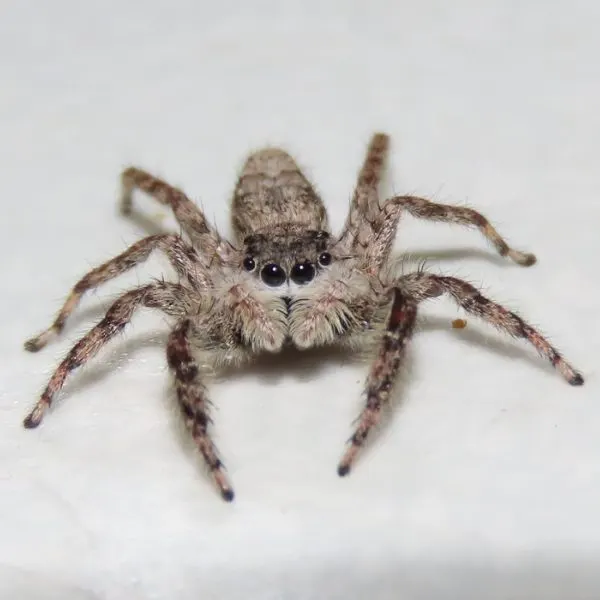
- Experience Level: Beginner
- Family: Salticidae
- Scientific Name: Platycryptus undatus
- Other Names: Jumping Spider
- Adult Size: 0.33 to 0.51 inches
- Lifespan: 1 year
- Average Price Range: N/A
Tan jumping spiders are covered in whitish-gray and tan or brown to black hairs.
They have a broad cephalothorax and an abdomen bearing chevron markings in the middle. In most individuals, the chevron pattern tends toward white and is lighter than the rest of the abdomen.
You’ll usually find tan jumping spiders on vertical surfaces, such as walls, fence posts, and tree trunks. They prefer staying outdoors, so you’ll rarely encounter them indoors. In the fall, however, some tan jumping spiders may move indoors to deal with the weather.
Tan jumping spiders only spin silk to make safety lines and cocoons to protect their eggs. They don’t spin web traps, preferring, instead, to track down prey and subdue them with venom.
Luckily, the venom these arachnids produce is not medically significant. Bites are rare, but even the most serious bites will only produce mild reactions in allergic people.
10. Dimorphic Jumping Spider

- Experience Level: Beginner to Intermediate
- Family: Salticidae
- Scientific Name: Maevia inclemens
- Other Names: Jumping Spider
- Adult Size: 0.2 to 0.3 inches
- Lifespan: 1 year
- Average Price Range: N/A
Dimorphic jumpers are unique when compared to other jumping spiders in Minnesota. The most distinctive feature of this species is the physical dimorphism males display in adulthood.
While female dimorphic jumping spiders look more or less the same, males come in two distinct forms or morphs. One morph is gray, while the other is called the black or the tufted morph.
The gray morph has orange pedipalps, is covered in black and white stripes, and lacks tufts. The black morph, however, has three black tufts on its head. The body is black the legs are light.
It’s still not clear why males exhibit this dimorphism, so it’s hard to tell how any given male will turn out in adulthood. Interestingly, the distribution of both morphs is usually roughly the same in most dimorphic jumping spider populations.
Females are brown with pale legs. The upper side of the abdomen has a chevron marking in the middle and orange scales or markings on the sides.
Like other jumping spiders, dimorphic jumpers are skilled hunters that don’t rely on web traps. They only spin silk safety lines to help when jumping and build silk cocoons to protect their eggs.
This species is safe to play with. Although it might bite when threatened, the venom it produces is harmless to humans and large pets.
11. Bronze Jumping Spider

- Experience Level: Beginner
- Family: Salticidae
- Scientific Name: Eris militaris
- Other Names: Bronze Jumper, Bronze Lake Jumping Spider, Bronze Lake Jumper
- Adult Size: 0.19 to 0.35 inches
- Lifespan: 1 year
- Average Price Range: N/A
The bronze jumper is a fine spider with a lustrous bronze-colored cephalothorax and abdomen. While the cephalothorax is often darker than the abdomen, both bear light brown to cream-colored hairy stripes on their sides.
Bronze jumpers usually hang out in the same places other spiders do. This means you’ll typically encounter them outdoors on wall surfaces, fences, or trees. You may also find them hopping on the ground on hiking trails and in gardens or forests.
Like other jumpers, this species is a hunter that doesn’t create web traps for prey. It feeds primarily on insects and other arthropods it seizes and subdues with venom. Even though it doesn’t use silk webs, the bronze jumper spins silk for draglines and egg sacs.
Bronze jumpers are harmless spiders, so there’s no reason to fear if one jumps on your skin. They are lively arachnids that rarely bite and are fun to play with and watch.
12. Barn Funnel Spider
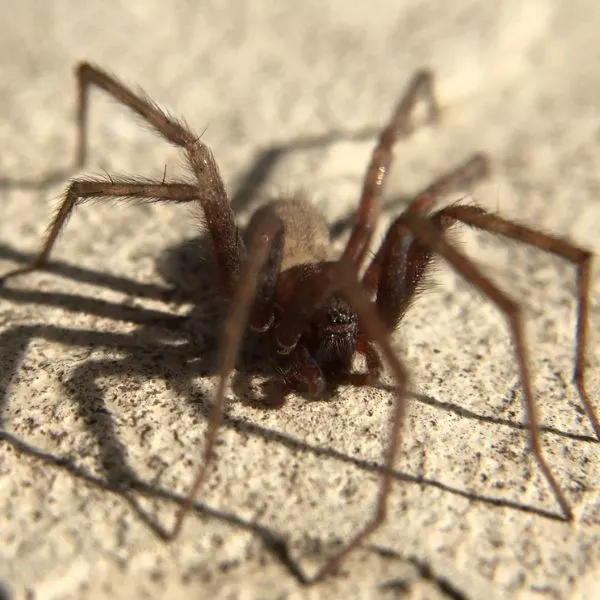
- Experience Level: Beginner
- Family: Agelenidae
- Scientific Name: Tegenaria domestica
- Other Names: Barn Funnel Weaver
- Adult Size: 0.24 to 0.45 inches
- Lifespan: 1 year
- Average Price Range: N/A
Barn funnel spiders live outdoors and indoors. Indoors, you’ll often find them stuck in kitchen or bathtub drains.
That’s how they earned the nickname drain spiders. They favor dark, damp places and corners, avoiding human interaction as much as possible.
The barn funnel weaver has spiny legs and is covered in black hair. The skin underneath is dark brown, but the abdomen is pale and almost white. Sadly, it doesn’t have any special identifying markings on its body besides the dark spots on its abdomen.
Unlike many funnel and orb-weaving spiders in Minnesota, the abdomen and cephalothorax aren’t much different in size. However, the carapace is hard and ridged in the middle, and the spider’s eyes are in front.
The barn funnel weaver does not pose any threat to humans. While it isn’t the most friendly spider, it rarely bites.
It only bites when provoked, but its venom is harmless. But bites can be painful.
13. False Black Widow

- Experience Level: Beginner
- Family: Theridiidae
- Scientific Name: Steatoda grossa
- Other Names: False Widow, Brown House Spider, Dark Comb-Footed Spider, Cupboard Spider
- Adult Size: 0.25 to 0.4 inches
- Lifespan: 1 to 6 years
- Average Price Range: N/A
Although Minnesota does not have real black widows, it is home to a sizable number of fakes. For people unfamiliar with true black widows, the false black widow can sometimes seem like the real thing.
This spider has a large, bulbous abdomen similar to that of a true widow. The body varies in color and can be brown or almost black. When black, the hue is usually closer to purple than pure black.
The easiest way to tell a false black widow from a real one is to examine the abdomen. True black widows have a distinct red hourglass-shaped marking on their bellies. However, false black widows don’t.
False black widows are distant relatives of true black widows, so they have a neurotoxic similar to black widows. Fortunately, the venom of false black widows is not medically significant.
These spiders do not bite unprovoked. But if one bites you, you’ll be fine without medical attention.
The main symptom might be some pain in the bite area that disappears on its own within a day.
14. Rabbit Hutch Spider
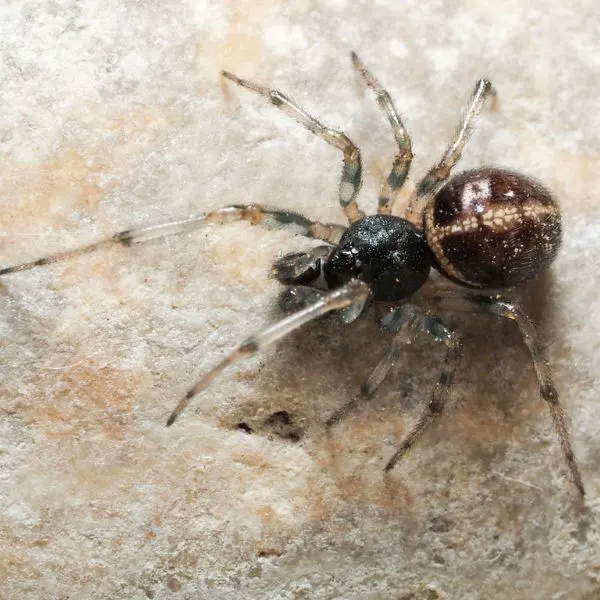
- Experience Level: Beginner
- Family: Theridiidae
- Scientific Name: Steatoda bipunctata
- Other Names: False Black Widow
- Adult Size: 0.31 inches
- Lifespan: 1 to 6 years
- Average Price Range: N/A
The rabbit hutch spider is another relative of true black widows.
While it shares the same family with black widows, it is pretty harmless compared to them. It injects venom when it bites, but this venom is not medically significant.
You can tell rabbit hutch spiders apart from true widows by the absence of a red hourglass marking on their abdomen. Rabbit hutch spiders also have a light stripe running down the center of their black to dark brown abdomens.
The abdomen of rabbit hutch spiders is large and bulbous, like that of black widows. But rabbit hutch spiders lack the same glossy appearance widows have. Without all these distinctions, you might misidentify rabbit hutch spiders as widows.
Rabbit hutch spiders are carnivorous, and they build cobwebs to trap prey. When other arthropods get tangled in their webs, the spiders swoop in to deliver a deadly bite. They digest their victims afterward.
You’ll find rabbit hutch spiders indoors and outdoors. Indoors, they favor dark, undisturbed places.
Their webs are an unpleasant sight, but they help control the populations of unwanted insects.
15. Triangulate Combfoot

- Experience Level: Beginner
- Family: Theridiidae
- Scientific Name: Steatoda triangulosa
- Other Names: Triangulate Cobweb Spider, Triangulate Bug Spider
- Adult Size: Up to 0.25 inches
- Lifespan: 1 to 3 years
- Average Price Range: N/A
The triangulate cobweb spider gets its name from the triangular patterns on its abdomen.
You’ll notice the triangular markings are the light brown spaces between pairs of wavy dark brown bands running down the spider’s abdomen. In most individuals, the triangular markings have whitish spots.
Triangulate cobweb spiders are false black widows. They share the same genus, and their venom is similar. However, they are safe to be around. Bites might hurt, but their venom is medically insignificant.
You’ll usually find these spiders in house corners or abandoned and infrequently cleaned spots. They spin cobwebs, which they use to catch prey like gnats, flies, and mosquitoes.
16. Flea Jumping Spider

- Experience Level: Beginner to Intermediate
- Family: Salticidae
- Scientific Name: Naphrys pulex
- Other Names: Jumping Spider
- Adult Size: 0.125 to 0.75 inches
- Lifespan: 1 year
- Average Price Range: N/A
The flea jumper is a tan and black spider with brown splotches.
Its tan legs are spiny with dark brown to black markings. Like other jumping spiders in Minnesota, the difference between the size of its abdomen and cephalothorax is negligible.
This species is widespread in North America. You’ll typically find it in woodlands, prairies with tall grasses, or forests with leaf litter. Since it favors vertical surfaces, it often stays on leaf blades, tree barks, or walls and fence posts.
Flea jumpers mainly eat arthropods, but insects make up the bulk of their diet. They have keen eyesight that helps them detect prey and attack effectively. Unlike most spiders in Minnesota, they don’t spin silk to snare prey.
These arachnids reserve their silk for making draglines when jumping or for spinning cocoons for their eggs. Females guard their eggs fiercely until they hatch into spiderlings.
Flea jumpers are lively spiders that rarely bite. So you’re perfectly safe playing with them, and they can be fun to observe in action.
17. American Grass Spider
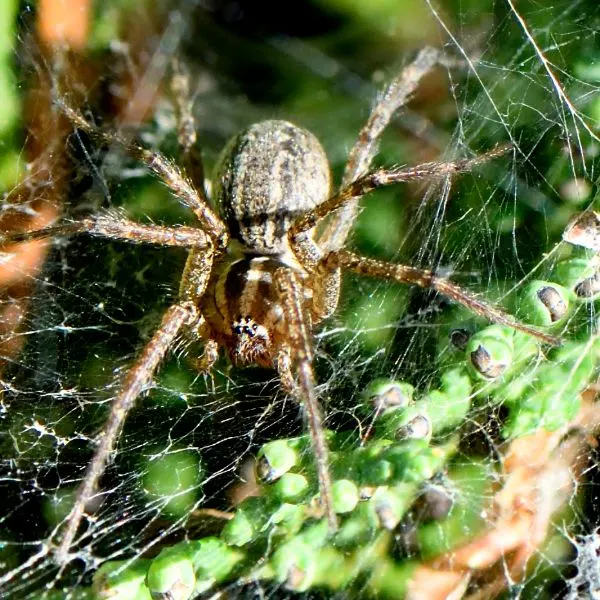
- Experience Level: Beginner
- Family: Agelenidae
- Scientific Name: Agelenopsis spp
- Other Names: Funnel Weavers, Sheet Web Spiders, Funnel Web Spiders, Ground Spiders
- Adult Size: 0.4 to 0.8 inches
- Lifespan: 1 year
- Average Price Range: N/A
American grass spiders are brown and gray or black with a wide cephalothorax and an oblong-ish abdomen.
The rear of this abdomen often ends in two pikes. On the carapace, you’ll notice two dark bands and three light lines running from head to waist.
The abdomen of these arachnids bears black stripes and black spots, while the brown legs are covered in dark mottles. At first glance, they resemble hobo spiders. But hobo spiders don’t have the three light lines on this species’ carapace.
American grass spiders are funnel weavers, and they rely on their nests to catch prey. They rarely leave their shelter unprovoked, but they will run if predators attack them. While they are venomous, they only sting people when they can’t escape.
The venom of this spider is not medically significant, so there’s no need to worry. You might develop redness and mild swelling or itchiness where this spider bites you, but these fade quickly.
You’ll usually find American grass spiders in prairies and most parts of Minnesota with green vegetation. Most sightings are outdoors, so you’re unlikely to encounter this spider inside your house.
18. Dark Fishing Spider

- Experience Level: Beginner
- Family: Pisauridae
- Scientific Name: Dolomedes tenebrosus
- Other Names: Dock Spider, Wharf Spider, Raft Spider
- Adult Size: 0.27 to 1.02 inches
- Lifespan: 1 to 2 years
- Average Price Range: N/A
The dark fishing spider is a relative of nursery web spiders.
It can walk on water and sometimes dives under to catch prey or escape predators. Although it mainly eats arthropods, it also sometimes consumes non-arthropod prey like slugs and tiny fishes.
This critter has no use for typical webs since it doesn’t use them in catching prey. However, it still uses silk to spin sacs for its eggs. Females guard their eggs sacs dutifully until the eggs hatch.
Even though this species is a fishing spider, it doesn’t limit itself to streams and other aquatic bodies. You’ll find the dark fishing spider in forests, woodlands, and meadows. It is an opportunistic feeder, so it can survive in many habitats.
The dark fishing spider has a hairy body covered in brown and black mottles. It also has some white markings, and its brown legs have dark splotches and bands. In addition, the upper side of the abdomen has dark W-shaped markings.
Don’t panic if you see this spider in damp parts of your building. It doesn’t bite unless you provoke it, and its venom is harmless.
However, you might experience temporary pain and redness.
19. Striped Fishing Spider

- Experience Level: Beginner
- Family: Pisauridae
- Scientific Name: Dolomedes scriptus
- Other Names: Fishing Spider
- Adult Size: Up to 1 inch
- Lifespan: 1 to 2 years
- Average Price Range: N/A
The striped fishing spider is a close relative of the dark fishing spider.
If you don’t look closely at it, you might even mistake it for the dark fishing spider. Both species share similar physical features, including W-shaped patterns on the upper side of their abdomens.
Despite their differences, you can still tell them apart by examining their abdomens. The dark W-shaped patterns in striped fishing spiders alternate with white W-shaped patterns. But the W-shaped patterns in dark fishing spiders do not.
Striped fishing spiders are generally lighter than dark fishing spiders. They are usually tan, brown, and gray. Their carapace has dark markings and a broad white or tan stripe on the sides of their bodies.
These arachnids, like other fishing spiders, can walk on water. They survive minutes submerged in water to escape predators or to catch prey. Although they are comfortable in and around water, these spiders also live in other places like forests, woodlands, and damp buildings.
You’ll usually find striped fishing spiders with their legs stretched out on all sides. While this posture makes them appear large and intimidating, they are not aggressive spiders.
They rarely bite, and their venom is not medically significant.
20. Filmy Dome Spider

- Experience Level: Beginner
- Family: Linyphiidae
- Scientific Name: Neriene radiata
- Other Names: Sheet web-weavers
- Adult Size: 0.14 to 0.25 inches
- Lifespan: 1 year
- Average Price Range: N/A
The filmy dome spider is a tiny brown spider with long legs and a large abdomen.
The middle of the carapace and abdomen have a broad, brown stripe. However, the sides of the carapace and most parts of the abdomen are yellowish-white.
The name of this spider comes from the dome-like shape of its webs, which it uses to snare prey. You’ll usually find its nests in woodlands and places with low vegetation. Indoors, it tends to stay in corners and undisturbed parts of the house.
Filmy dome spiders are solitary spiders, so you’ll rarely see them in the company of other spiders. Mating seasons are the only time it’s common to encounter filmy spiders sharing their webs with mating partners.
While females live longer than males, their life cycle usually ends within a year. Males die shortly after mating, and females don’t survive winter.
These spiders are not aggressive or dangerous. Their venom is only effective against prey but is harmless to humans.
Since they are tiny, it’s unlikely that their fangs will puncture you deeply enough to cause any symptoms.
21. Goldenrod Crab Spider

- Experience Level: Beginner to Intermediate
- Family: Thomisidae
- Scientific Name: Misumena vatia
- Other Names: Smooth Flower Crab Spider, Flower Spider, Flower Crab Spider
- Adult Size: 0.125 to 0.75 inches
- Lifespan: 1 year
- Average Price Range: N/A
The goldenrod crab spider is a beautiful yellow spider with a large abdomen.
The abdomen has a long red streak or rod-like pattern on each side. Like crabs, the first two legs are larger than the rest, and they can move sideways.
This arachnid spends virtually all of its time in flowerheads, where it lives and waits for prey. Most goldenrod crab spiders are passive hunters, ambushing insects that come to pollinate the flowers they live on.
Goldenrod crab spiders are unique because they can change their colors from white to green and vice versa. Although this color change can take days to complete, it helps conceal them from unsuspecting prey.
These critters don’t spin silk to catch prey. However, they use silk to create cocoons for their eggs. Females guard their egg sacs diligently until spiderlings emerge.
Sadly, females die shortly after the eggs hatch. But males die much earlier.
Goldenrod crab spiders don’t attack people unless threatened. If one bites you, there’s no need to worry. The spiders don’t produce toxic venom.
22. Running Crab Spider

- Experience Level: Beginner
- Family: Philodromidae
- Scientific Name: Philodromus spp.
- Other Names: Crab Spiders
- Adult Size: Up to 0.75 inches
- Lifespan: 1 year
- Average Price Range: N/A
The running ground crab spider is a swift predator that relishes stalking and subduing prey.
Unlike flower crab spiders, it is not passive hunter. You’ll usually find it on the ground running after prey or seeking shelter.
This critter is tan to dark brown with spiny, banded legs. Like other crab spiders, its first pair of legs are larger than the rest.
The body is mottled with dark spots, and the middle of its carapace is lighter than the sides. But it has no distinct pattern.
Since it is a hunter, it does not spin silk traps for prey. But females spin egg sacs, which they guard until the eggs hatch. Unfortunately, females die a while after their eggs hatch into spiderlings.
Running crab spiders are fun to watch in action, and they aren’t dangerous. They will only bite if threatened without escape, but their venom is not medically significant.
23. Long-bodied Cellar Spider

- Experience Level: Beginner
- Family: Pholcidae
- Scientific Name: Pholcus phalangioides
- Other Names: Daddy Longlegs, Granddaddy Longlegs, Cellar Spider, Daddy Longlegger, Carpenter Spider, House Spider, Vibrating Spider, Skull Spider
- Adult Size: Up to 0.4 inches
- Lifespan: 2 years
- Average Price Range: N/A
Cellar spiders are one of the most well-known spiders in the world.
They have long legs that may be more than six times their body length. As a result, these spiders are often called daddy longlegs.
These arachnids have small, long bodies with bulbous abdomens. However, they often appear larger than they are because of their long legs. Daddy longlegs spiders are typically tan or light brown.
You’ll usually spot this species indoors. It builds its webs in window sills, wall corners, furniture bends, and ceiling corners in almost any part of the house.
However, the spider favors undisturbed and infrequently cleaned spots.
Long-bodied cellar spiders have poor eyesight and rely on building webs to catch arthropod prey. They wait for prey and use vibratory signals to locate potential victims caught in their webs. When confronted by predators, they run away or shake their webs vigorously until the webs become blurry.
These spiders are harmless to human beings. It’s unclear whether their fangs penetrate human skin deeply, but their venom is mild.
Even if one bites you, you’re unlikely to feel anything. At most, the spot might feel itchy.
24. Long-palped Ant Mimic Sac Spider

- Experience Level: Beginner
- Family: Corinnidae
- Scientific Name: Castianeira longipalpa
- Other Names: Ant Mimic Spider
- Adult Size: 0.2 to 0.4 inches
- Lifespan: 1 year
- Average Price Range: N/A
Long-palped ant mimic sac spiders are similar to red-spotted ant mimic spiders.
Like their relatives, they walk with their first pair of legs raised up to mimic the antennae of true ants. But, overall, long-palped ant mimic sac spiders don’t look very much like ants.
Long-palped ant mimic sac spiders are predatory arachnids that feed on insects and small arthropods. Since ants are their choice prey, their behavioral adaptation makes hunting them easier.
The abdomen of this species is typically black with many light stripes. The brown, black, gray, or sometimes whitish cephalothorax is often larger than the abdomen. Finally, the legs are dark brown or black and may or may not have whitish bands.
Although these spiders are hunters, they spin webs for other purposes. The “sac” in their name comes from their tendency to spin sac-like shelters for them to retreat into and rest. They also spin cocoons around their eggs.
Long-palped ant mimic sac spiders don’t inject people with medically significant venoms. Their bites can hurt, but these critters rarely sting unprovoked.
Their default response is to run from threats.
25. Northern Yellow Sac Spider
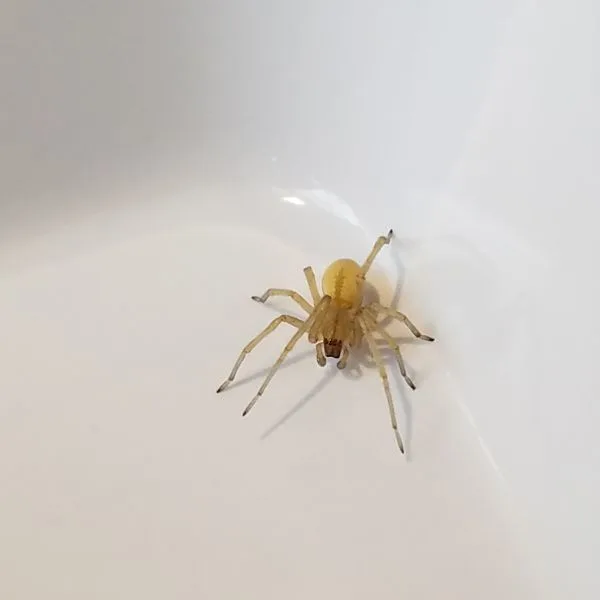
- Experience Level: Beginner
- Family: Eutichuridae
- Scientific Name: Cheiracanthium mildei
- Other Names: Long-legged Sac Spider
- Adult Size: Up to 0.4 inches
- Lifespan: 1 year
- Average Price Range: N/A
The northern yellow sac spider was introduced to the US from Europe, but it has since spread to many parts of the country. It has a pale yellow body with a greenish tinge, while the mouthparts are dark.
While it has an unsettling appearance, it is not dangerous. But this is not a license to mishandle it.
Even though its venom is not medically significant, its bites can be painful if you’re allergic. Some people might develop mild fevers and unpleasant skin reactions.
Northern yellow sac spiders are ruthless hunters, so they direct their aggressiveness toward arthropods. Although they don’t build conventional webs to trap prey, they spin silk sacs to use as shelter. Females also spin protective sacs for their eggs.
This species usually lives outdoors and indoors. Outdoors, it lives under foliage and debris. It favors corners when it lives indoors.
This nocturnal hunter often retreats into its shelter at daybreak, so you might be unaware you have northern yellow sac spiders in your home.
26. Arrowhead Orbweaver

- Experience Level: Beginner
- Family: Araneidae
- Scientific Name: Verrucosa arenata
- Other Names: Arrowhead Spider, Triangulate Orb-weaver
- Adult Size: 0.15 to 0.55 inches
- Lifespan: Up to 1 year
- Average Price Range: N/A
The arrowhead orb-weaver gets its name from the shape of its abdomen.
The abdomen is triangular or shaped like an arrowhead. In addition, the upper side of its abdomen bears a large, arrowhead-like pattern.
Arrowhead orb-weavers are typically tea brown, but the abdominal pattern is yellow, whitish, or pinkish. The part of the abdomen without the arrowhead pattern is reddish-brown with whitish or yellowish spots.
Like other orb-weavers, this species spins orb-like nets to trap prey. It then stays on its web and patiently waits for prey to come to get stuck before attacking. It typically builds its web in dimly lit areas and sits with its head facing up.
You have nothing to fear from this arachnid. It doesn’t bite unprovoked, and its venom is harmless to humans.
27. Eastern Parson Spider

- Experience Level: Beginner
- Family: Gnaphosidae
- Scientific Name: Herpyllus ecclesiasticus
- Other Names: Stealthy Ground Spider, Ground Spider
- Adult Size: 0.3 to 0.8 inches
- Lifespan: 1 to 2 years
- Average Price Range: N/A
The eastern parson spider is covered in thick black or dark gray hairs.
You can identify it by the two pikes at its rear and the whitish pattern on its back. This pattern looks like the neckband Catholic clergymen wore in the 18th century.
Clergymen are also called parsons, hence this spider’s name.
Eastern parson spiders are skilled predators. These hunters are swift on their feet, chasing prey and paralyzing their victims with venom before feasting. In addition to being skilled at hunting, these spiders are also efficient at escaping predators.
These arachnids run in an unusual zigzag pattern, making it hard for predators to catch them. Although they run when threatened, these spiders don’t hesitate to sting humans and potential predators when they feel trapped.
Thankfully, the venom eastern parson spiders inject is not medically significant to humans. But their bites can be pretty painful.
You’ll usually come across these spiders in forests and bushes, where they hide under rocks and debris. Indoor sightings are also common in some places.
Since they are nocturnal, you might not know you have these arachnids in your home.
28. Spotted Orbweaver
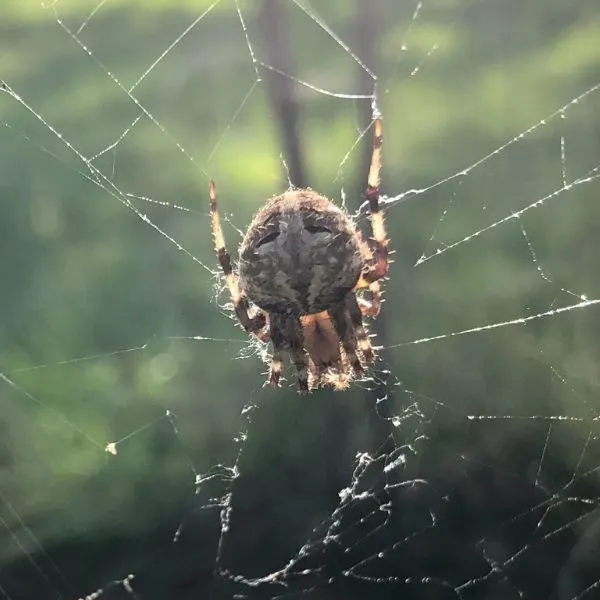
- Experience Level: Beginner
- Family: Araneidae
- Scientific Name: Neoscona crucifera
- Other Names: Barn Spider, Hentz Orb-weaver
- Adult Size: Up to 0.75 inches
- Lifespan: 1 year
- Average Price Range: N/A
The spotted orb-weaver comes in multiple shades, but most are brown with whitish hair on their carapace and spines on their abdomen. The abdomen is spotted and bears a wavy pattern that’s usually indistinguishable in adults.
Whitish hairs and spines cover the lower half of this species’ legs. However, the first half is usually brownish-orange with black spines. Despite its intimidating appearance, this arachnid is harmless to humans.
Spotted orb-weavers spin large, orb-shaped webs, which they use to snare prey. You’ll often find them in woodlands and forests or bushes, but many live in or around man-made structures. While they are generally nocturnal, it’s common to find females active during the day in the wild.
Like other spiders in Minnesota, female spotted spiders are larger than males. They also tend to consume males shortly after mating.
Females generally don’t survive winter, so they don’t raise their offspring.
29. Furrow Orbweaver
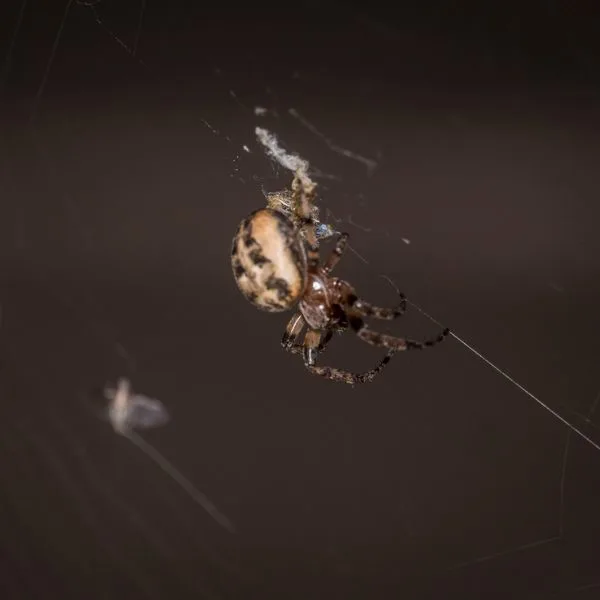
- Experience Level: Beginner
- Family: Araneidae
- Scientific Name: Larinioides cornutus
- Other Names: Furrow Orb Spider, Furrow Spider, Foliate Spider
- Adult Size: 0.4 to 0.5 inches
- Lifespan: 1 Year
- Average Price Range: N/A
The furrow orb-weaver comes with black, gray, and brown colors on its body. The carapace is dark, while the tan or gray abdomen has a dark pattern with wavy edges running down the center.
These wavy lines look like the edges of serrated leaves or the furrows left behind after tilling the soil. This resemblance is where furrow orb-weavers get their name from.
You may encounter furrow orb-weavers in and around man-made structures or in forests and woodlands. They spin large, round webs, which they use for shelter and for snaring prey.
Furrow orb-weavers also spin sacs around their eggs to protect them. Although these spiders do not live long, they keep their eggs safe for as long as they can. Males usually die after mating, but females live longer.
Furrow orb-weavers are not dangerous, so there’s no reason to fear them. They rarely bite unprovoked, and their venom is not medically significant.
Any symptoms you develop following a bite will fade quickly.
30. Gray Cross Spider
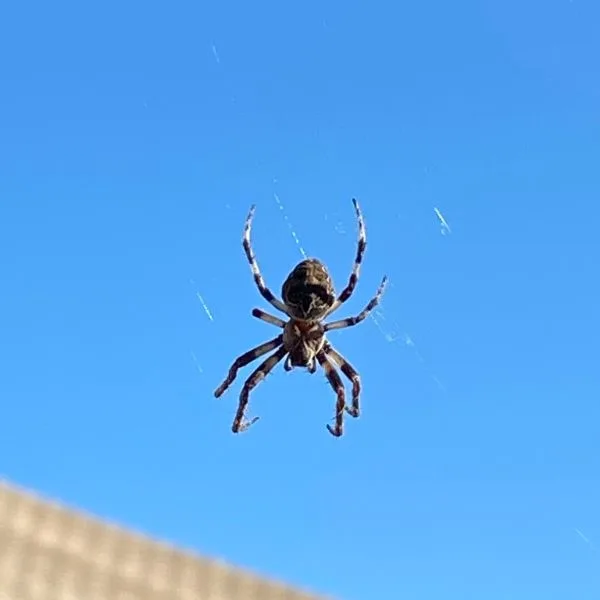
- Experience Level: Beginner to Intermediate
- Family: Araneidae
- Scientific Name: Larinioides sericatus
- Other Names: Bridge Orb-weaver, Bridge Spider
- Adult Size: 0.31 to 0.55 inches
- Lifespan: 1 year
- Average Price Range: N/A
Also called the bridge orb-weaver, this arachnid is closely related to the furrow orb-weaver.
Its main distinguishing feature is the cross-shaped pattern on the back of its abdomen. Furrow orb-weavers lack this pattern.
Gray cross spiders are called bridge orb-weavers because people often sight them near bridges and other man-made structures, especially ones made of steel. They likely favor bridges because the water under bridges often reflects light.
Since light attracts insects, bridges and other well-lit locations provide an excellent food supply. Gray cross spiders aren’t hunters, so they usually sit back and let insects get tangled in their webs. They then sting these insects before feasting on them.
There’s nothing to fear about these spiders. They don’t attack people unprovoked, and their venom is harmless to humans.
31. Arabesque Orbweaver

- Experience Level: Beginner
- Family: Araneidae
- Scientific Name: Neoscona arabesca
- Other Names: Orb-weaver
- Adult Size: 0.20 to 0.28 inches
- Lifespan: 1 Year
- Average Price Range: N/A
Arabesque orb-weavers are closely related to spotted orb-weavers.
Their name comes from the resemblance of their abdominal pattern to Arabic designs from Moorish times. Although they come in various colors from yellow to dark brown, you can distinguish them by the slanting marks on their abdomen.
You’ll find these spiny-legged spiders in many parts of Minnesota, but they favor areas with vegetation. Here, they build large wheel-shaped webs to catch prey. They aren’t hunters, so they wait for prey to get stuck in their webs before attacking.
Arabesque orb-weavers are beneficial to you and the environment. Since they often cast large orb-shaped nests, they help control pests like mosquitoes, flies, and beetles. They are also pleasing to look at.
Like other orb-weavers in Minnesota, this species is safe to have around. It does not bite unless threatened without a way to escape.
Even then, its venom doesn’t cause any significant symptoms.
32. Marbled Orbweaver

- Experience Level: Beginner
- Family: Araneidae
- Scientific Name: Araneus marmoreus
- Other Names: Pumpkin Spider
- Adult Size: 0.2 to 0.7 inches
- Lifespan: Less than 1 year
- Average Price Range: N/A
You’ll find the marbled orb-weaver in many parts of Minnesota.
This stunning spider has yellow and black marble-like patterns on its large, round abdomen. Although its body is orange to brown, the fangs and the second half of its legs have black and translucent bands.
This species is not a hunter, so it builds orb-shaped webs to trap prey. The bulk of its prey consists of insects like flies, beetles, and moths, but it isn’t picky about its food. Once it detects prey stuck in its web, it rushes toward its victim and delivers a lethal bite.
Marbled orb-weavers may be aggressive toward prey, but they are pretty timid when faced with predators. Their default reaction is to run away, but they are likely to fight back if there’s no way to escape.
The pattern on marbled orb-weavers is beautiful, so you might want to consider keeping these arachnids as pets. They are perfectly safe to keep since the venom they produce isn’t enough to cause you any serious harm.
Most times, marbled orb-weavers build their webs in forests, fields, and meadows. You may also encounter marbled orb-weavers in other parts of Minnesota, including residential areas.
Individuals living close to homes often spin their webs in house gardens and mailboxes.
33. Cat-faced Spider

- Experience Level: Beginner
- Family: Araneidae
- Scientific Name: Araneus gemmoides
- Other Names: Jewel Spider, Cat-faced orb-weaver
- Adult Size: 0.2 to 1 inch
- Lifespan: 1 year
- Average Price Range: N/A
The cat-faced spider is an orb-weaving arachnid with a large, hairy abdomen and spiny, banded legs.
From a distance, the contours on its abdomen resemble the face of a cat. The abdomen also has two annular projections, which is why this species is also called a jewel spider.
This species is capable of switching colors from light to dark and back over a long period, which can make identifying it difficult. Its cat-like features are the best way to identify it.
You’ll encounter this species in different parts of Minnesota, especially around homes. Individuals that live in or near homes tend to build their nests near light sources. Presumably, this exposes them to lots of light-loving insects to prey on.
Cat-faced orb-weavers build wheel-shaped webs to snare their victims. Their eyesight isn’t as keen as that of hunter spiders in Minnesota, so they rely largely on vibratory signals from prey struggling to escape from their nests.
These spiders don’t live long, and females often die immediately after laying eggs. Although they lay plenty of eggs, only a few spiderlings make it to adulthood. The spiderlings often eat each other, so only those left survive.
Like other orb-weavers in Minnesota, this species is harmless to people. You can keep it around or play with cat-faced orb-weavers.
They won’t bite unless you mishandle them.
34. Bowl and Doily Spider

- Experience Level: Beginner
- Family: Linyphiidae
- Scientific Name: Frontinella pyramitela
- Other Names: Sheet-weavers
- Adult Size: Up to 0.15 inches
- Lifespan: 1 year
- Average Price Range: N/A
The bowl and doily spider is a brown spider with a lustrous carapace and abdomen.
You can identify it by the whitish vertical comma-shaped marks on the sides of its belly. Underneath, the whitish pattern turns yellowish.
This spider gets its name from the shape of its web. It spins a flat, doily-like web under a bowl-shaped one. You’ll usually find its large webs anchored between tree branches in the forest.
Because its web is pretty distinctive, you can tell the spider is around just by looking at its nest. The spider often waits for prey outside the bowl (on the doily) or inside the bowl (at the bottom).
The nest this spider builds is not sticky, so it relies on its swiftness at stinging trapped insects. It also has a thick silk tangle above the opening of the bowl. Flying insects that crash into this tangled silk fall into the bowl, where the spider is ready to immobilize them.
Spider nests usually only have one female residing in them. However, you’ll sometimes find a male and female bowl and doily spider living in the same web.
This cohabitation occurs outside mating seasons, and males and females living in the same nest often compete with each other for prey.
35. Orchard Orbweaver

- Experience Level: Beginner
- Family: Tatragnathidae
- Scientific Name: Leucauge venusta
- Other Names: Long-jawed Orb-weaver
- Adult Size: 0.14 to 0.3 inches
- Lifespan: 1 year
- Average Price Range: N/A
Orchard orb-weavers favor orchards, but you can find them elsewhere.
These spiders often hang out in gardens, fields, and forests. Like other orb-weaving species, they spin round webs and have a belly that’s larger than their cephalothorax.
You can easily identify these spiders by the dark venous pattern on their slanted abdomens. Their abdomen is whitish with yellow, orange, and green splotches. In addition, the legs are green, while the carapace is yellowish with a dark central stripe.
These arachnids feed on arthropod prey, especially insects. They wait patiently in their nests for insects to get tangled before attacking. Feeding commences after they have immobilized their victims.
Orchard orb-weavers rarely bite people, and their venom is harmless to humans. Except when threatened and have no escape, they aren’t aggressive towards people.
36. White Micrathena
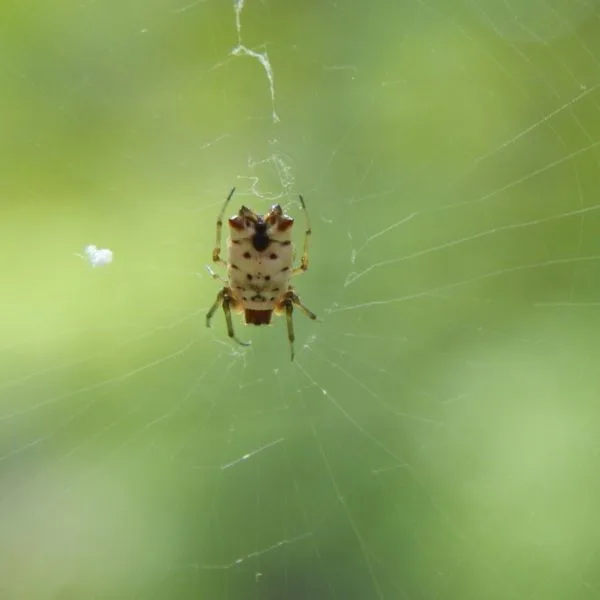
- Experience Level: Beginner to Intermediate
- Family: Araneidae
- Scientific Name: Micrathena mitrata
- Other Names: Orb-weaver
- Adult Size: Up to 0.2 inches
- Lifespan: 1 year
- Average Price Range: N/A
The white micrathena is an orb-weaver with brown, pointed protrusions at the rear of its belly.
While most individuals have four pointed protrusions, it’s possible to come across individuals with more. The abdomen of this species is usually white or cream-colored and littered with dark brown or black blotches.
This spider’s carapace and legs are brown, but the legs are darker at the joints. It spins orb-like webs and hangs head-down in the middle, waiting for prey to get stuck before attacking.
Although not everyone is warm towards this species, it helps in controlling the population of insect pests. The bulk of its diet includes insects like mosquitoes and other flying insects.
White micrathenas can seem creepy or beautiful: how you see them depends on how tolerant you are of spiders. Regardless, these spiders aren’t dangerous.
They don’t bite unprovoked, and their venom is harmless to people.
37. Spined Micrathena
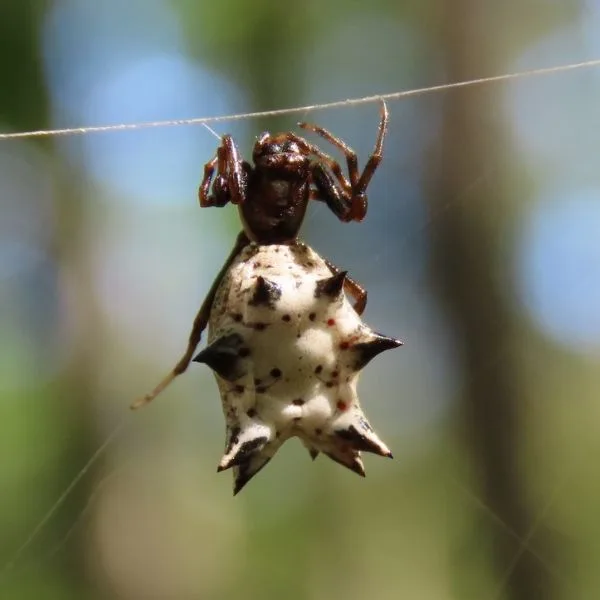
- Experience Level: Beginner
- Family: Araneidae
- Scientific Name: Micrathena gracilis
- Other Names: Castleback Orb-weaver
- Adult Size: 0.2 to 0.4 inches
- Lifespan: 1 year
- Average Price Range: N/A
The spined micrathena is a sibling of the white micrathena, but you can easily differentiate both species. Unlike the white micrathena, the pointed tubercles of the spined micrathena aren’t restricted to the rear.
The spined micrathena often has a brown to black carapace with dark brown or black pointy projections on the sides and rear of its large abdomen. This abdomen is usually white with dark blotches.
Like most spiders in Minnesota, females are larger than males. Females are also the dominant sex, as most spined micrathenas you’ll encounter are females. They also tend to live longer.
You’ll usually spot spined micrathenas on leaves or hanging upside-down in the middle of their nest. Since they aren’t hunters, they wait here for prey to wander into their nests before immobilizing their victims.
Spined micrathenas aren’t dangerous to humans. They don’t inject medically significant venom and scarcely bite, so you shouldn’t fear them.
38. Giant Lichen Orbweaver

- Experience Level: Beginner
- Family: Araneidae
- Scientific Name: Araneus bicentenarius
- Other Names: Orb-weaver
- Adult Size: Up to 1 inch
- Lifespan: 1 year
- Average Price Range: N/A
The giant lichen orb-weaver is a reddish-brown to light brown spider with a dark carapace and spiny, banded legs. Its large abdomen has a greenish pattern that resembles lichen found on rocks, hence the spider’s name.
You’ll typically find this species in places with ample vegetation, such as forests, gardens, and shrublands. It spins large nests that can be up to 8 feet in diameter.
Unlike most of the other orb-weavers in Minnesota, it does not hang head-down in its web. It stays upright.
Giant lichen orb-weavers are carnivores that feed primarily on insects. They depend on their orb-shaped nests to trap prey for them. When an insect gets stuck, the spiders rush towards it to immobilize it with venom.
The venom these arachnids inject often kills prey, but it is harmless to human beings. Although bites are rare, even the most extreme reactions are mild and typically fade quickly.
39. Starbellied Orbweaver

- Experience Level: Beginner
- Family: Araneidae
- Scientific Name: Acanthepeira stellata
- Other Names: Star-bellied Spider
- Adult Size: 0.19 to 0.59 inches
- Lifespan: 1 year
- Average Price Range: N/A
The star-bellied orb-weaver is a brown spider with a large spiky abdomen. The spikes surround the top edges of the abdomen, but the middle usually lacks spikes and is dark brown with white streaks.
You’ll often find this arachnid in prairies and meadows, where it feeds on beetles, wasps, flies, and other insects caught in its orb-shaped nest. You may also encounter it around homes and other man-made structures.
Like most spiders in Minnesota, females of this species are larger than males. They also tend to live longer and are the sex you’ll usually encounter. They spin silk sacs to protect their eggs.
Spiderlings emerge from the egg sacs and live together for a short period before parting ways.
It’s easy to think of star-bellied spiders as dangerous because of their peculiar shape, but they aren’t. The venom they produce is harmless to humans, and they don’t bite unless threatened.
40. Candy-striped Spider
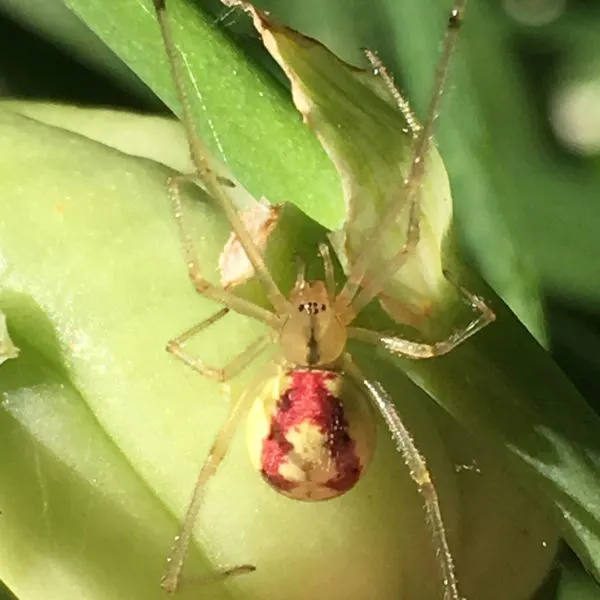
- Experience Level: Beginner to Intermediate
- Family: Theridiidae
- Scientific Name: Enoplognatha ovata
- Other Names: Common Candy-striped Spider
- Adult Size: 0.25 inches
- Lifespan: 1 year
- Average Price Range: N/A
The candy-striped spider is one of the more colorful distant relatives of black widows.
This cobweb spider is yellowish-green or cream-colored with two reddish stripes in the center of its abdomen. Unlike most members of its family, it almost strictly lives outdoors among vegetation. Indoor sightings are rare.
This polymorphic spider appears in three forms that you can differentiate fairly easily. The redimita morph is the most common, and it has a black-spotted cream to a yellowish-green area between the two reddish stripes.
In the ovata morph, there is no light space between the two reddish stripes. Instead, both merge into one broad stripe. The lineata morph lacks reddish stripes and has several black spots instead.
Candy-striped spiders are originally from Europe, but they are now well-established in the US. They scarcely bite unprovoked and don’t pose any serious danger to humans.
However, their bite can result in a painful but mild swelling that fades without treatment.
They mainly prey on insects and other small arthropods that they immobilize with their venom. Since they aren’t hunters, they usually build tangled webs to trap their victims before attacking.
Frequently Asked Questions
You probably still have questions about spiders in Minnesota. Read on to find the answers to your most pressing questions.
What do spiders in Minnesota eat?
Spiders in Minnesota eat the same things spiders everywhere eat: arthropods. Insects like flies, ants, gnats, and beetles are among their favorite snacks.
Many spiders in Minnesota also eat other spiders, and some even eat members of their species. Others, like fishing spiders, include non-arthropod prey like tiny fishes in their diet.
Do spiders in Minnesota have good eyesight?
Yes and no. Hunter spiders like jumping spiders and wolf spiders generally have good eyesight, which they use to track prey before attacking. Of their eight eyes, they use two for vision, while the others serve as keen motion detectors.
Species that rely on webs to catch prey, such as daddy longlegs, generally have poor eyesight. These functionally blind spiders often rely on vibratory signals and other senses to locate prey and potential threats.
Where can I find spiders in Minnesota?
Your home is the first place to check if you’re looking for spiders.
You’re likely to spot their webs in ceiling corners or window sills. Your attic, basement, and damp, undisturbed places in your garage are also excellent places to check.
If you’re looking for more diversity, you might need to check forests and bushes or shrublands for less common species. Web-spinning species often build webs between branches and leaves, while hunters tend to seek shelter under litter or other debris.
Are there any poisonous spiders in Minnesota?
Minnesota is home to many venomous spiders. In fact, virtually every spider in Minnesota is venomous. The good news is that none of these spiders carry venoms toxic enough to harm humans, so you’re safe.
Can a spider bite kill you?
Some sources inflict venomous bites that are potentially fatal. However, people rarely die from spider bites.
The high survival rate is because even highly venomous species like black widows don’t inject enough venom to cause death. Advances in medicine have also made treating venomous bites easier.
Fortunately, there are no spiders capable of killing humans in Minnesota.
What is the deadliest spider in Minnesota?
Minnesota doesn’t have any deadly spiders. However, you should be careful around northern yellow sac spiders and eastern parson spiders. Their venoms aren’t medically significant, but the bites they inflict can be very painful.
Are there brown recluses in Minnesota?
No. Minnesota doesn’t have any known brown recluse populations.
Are there black widows in Minnesota?
No. There are no black widows in Minnesota.
Although you’ll find a few websites that list black widows as native Minnesota species, this information is wrong. The state isn’t home to black widows.
Are there jumping spiders in Minnesota?
Yes. Minnesota is home to a variety of jumping spider species. These lively arachnids are fun to watch and generally safe to handle.
Are there tarantulas in Minnesota?
So far, there are no confirmed tarantula populations in Minnesota. The only tarantulas you’ll encounter in the state are likely introduced from other states.
Are Minnesota tarantulas poisonous?
Tarantulas are venomous, as virtually all spiders are.
Fortunately, their venom is usually not medically significant. Your chances of being bitten by one in Minnesota are low since the state doesn’t have confirmed tarantula populations.
Is it legal to own a pet spider in Minnesota?
Yes. You can own pet spiders in Minnesota without worrying about running into trouble with the law. Fortunately, many spiders in the state make excellent pets and aren’t harmful to you.
How many species of spiders are there in Minnesota?
It’s not clear how many spider species are in Minnesota. While some sources estimate the number to be over 500, only a little over 30 species are confirmed and frequently seen.
What are the most common spiders in Minnesota?
Orb-weavers are likely the most common spiders in Minnesota. The state has several orb-weaving species, each one different from the next. Besides orb-weavers, Minnesota also has substantial jumping spider populations.
Wrapping up
You’ll find many different spiders in Minnesota, but none of them cause any serious harm. If you love arachnids, the state has many beautiful and lively species you can keep as pets.
Although most spiders have short lifespans, they often produce many offspring and play vital environmental roles. They are also beneficial to have around your homes and gardens because of their mainly insect-based diet.
The spiders in Minnesota are highly diverse creatures, and their appearances can range from stunning to creepy. But you can live peacefully with most of them. Except their presence constitutes a serious nuisance, there’s no hurry in getting rid of them.
More spiders in nearby states

Joyce Passananti
Wednesday 16th of August 2023
This is very interesting and informative. Can I get a printout off this?